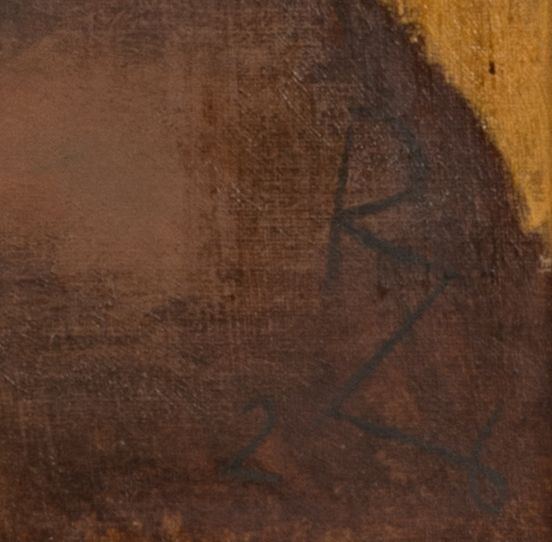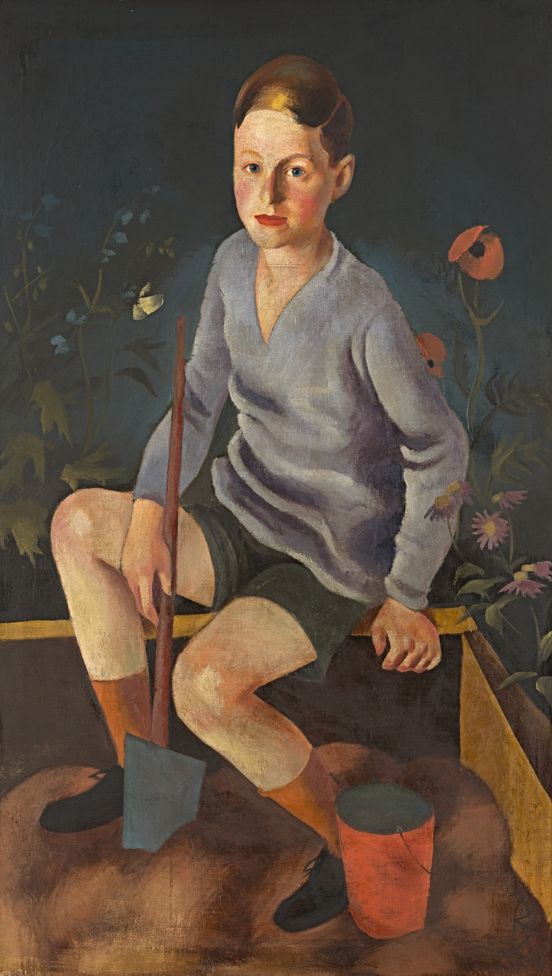| Genre | Painting |
| Materials | Oil on canvas |
| Size | 120 x 71 cm |
| Signature | signed and dated bottom right: “RZ 26” |
Research status
Provenance is unclear and research continues.

Unknown photographer, portrait of Rudolf Levy, undated
© Leo Baeck Institute
A misleading attribution to Rudolf Levy
When the painter Rudolf Levy (1875–1944) settled in Berlin in 1921, he already had an international reputation. In Paris before the First World War, he frequented the legendary Café du Dôme, a favourite haunt for trailblazing artists of the period. There he met the well-known gallery owner Alfred Flechtheim (1878–1937), who exhibited his paintings in Berlin from 1922 onwards.

Exhibition catalogue Rudolf Levy of the Alfred Flechtheim Gallery, cover, June 1922
© Universitätsbibliothek Heidelberg, https://doi.org/10.11588/diglit.70176#0001

Rudolf Levy, “Bildnis Max V.”, 1921, in: Exhibition catalogue Rudolf Levy of the Alfred Flechtheim Gallery, June 1922
© Universitätsbibliothek Heidelberg, https://doi.org/10.11588/diglit.70176#0009
From early 1933, Levy was persecuted in Germany because of his Jewish origins. He left the city, embarked on an odyssey through several countries and hoped in vain that he would be safe in Florence. In 1943 he was detained by the Gestapo, deported by truck and train to the extermination camp at Auschwitz and probably murdered upon arrival on 6 February 1944.
Many years later, Eberhard Roters (1929–1994), the former director of the Berlinische Galerie, was on the look-out for a painting by Levy to add to the museum’s collection. Roters was aware of Levy’s background and valued not only his quality as an artist but also his relevance to Berlin. At last, in March 1984, the opportunity for a purchase arose when the Berlin art dealer Hans-Joachim Bredow offered the museum the “painting of a boy in a sandbox” from his private collection.
“The painting ‘Boy in the Sandbox’ is a characteristic upright format in the artist’s style between Expressionism and New Objectivity from the middle of the 1920s.”
Eberhard Roters, in: Recommendation to Purchase Artworks for the State of Berlin, 20 June 1984
Research to establish the provenance of the painting initially led nowhere. It was unclear how it had ended up in the possession of Hans-Joachim Bredow. Moreover, there was no trace in the literature about Levy’s œuvre of a “Boy in the Sandbox”. After close scrutiny of his paintings from the 1920s, doubts arose about the attribution. Not only did the technique seem different from that of other works of the period, so did the artist’s mark. The doubts were confirmed when the monogram bottom right was attributed to the artist Richard Ziegler, whose painting “Girl with Jumping Jack” of 1925, which is dissimilar in style, has been in the collection since 1987.
This prompted deeper research into the work of Richard Ziegler. There is plenty to suggest that this painting was a commissioned portrait. We know that in 1928 the portrait of a girl among flowers (now lost) was in his studio. That painting and the boy in the sandbox can be regarded as a pair. So far, however, we have no idea who commissioned either painting. From what we know of other portraits, it is conceivable that the commission came from the family, but it could equally have come from someone else who appreciated Ziegler’s style. And so the origins of the “Boy in the Sandbox” and its provenance are still open questions.

Unknown photographer, Richard Ziegler in his studio, 1928, in the background the “Bildnis eines Mädchens vor Blumen”
© Cornelia Ziegler; Repro: Richard-Ziegler-Stiftung der Stadt Calw
© Cornelia Ziegler; Repro: Richard-Ziegler-Stiftung der Stadt Calw
The monogram “RZ” for Richard Ziegler
© VG Bild-Kunst, Bonn 2023

Richard Ziegler, Mädchen mit Hampelmann, 1925
© VG Bild-Kunst, Bonn 2020; Repro: Kai-Annett Becker
